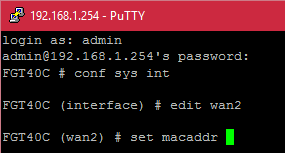 We recently had a customer take advantage of a free upgrade from FTTN (Fibre to the Node) to FTTP (Fibre to the Premise) for their NBN (National Broadband Network) service. However during cut-over the FortiGate wasn’t picking up connectivity on the WAN port, this had the on-site guy stumped for 10 minutes until we jumped on and took a look. In HFC days, you’d sometimes have to “spoof” the MAC address to get it working – but in this case it was something else… Ethernet auto-negotiate.
We recently had a customer take advantage of a free upgrade from FTTN (Fibre to the Node) to FTTP (Fibre to the Premise) for their NBN (National Broadband Network) service. However during cut-over the FortiGate wasn’t picking up connectivity on the WAN port, this had the on-site guy stumped for 10 minutes until we jumped on and took a look. In HFC days, you’d sometimes have to “spoof” the MAC address to get it working – but in this case it was something else… Ethernet auto-negotiate.
We hard-coded the WAN port to 100 full duplex and it kicked in like a charm. The following command lets you edit an interface and set the speed accordingly.
edit WAN1 set speed 100full end
While it’s not something I’ve experienced with Enterprise Ethernet installations, this also rings true in certain cases of fibre installs we would sometimes see customer NTDs or NTU (such as Cisco or MRV) also not connect for similar reasons, so liasing with the ISP we’d ensure both sides of the cable are set to the same setting.
